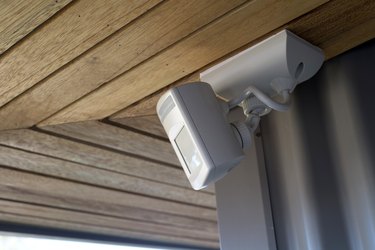
Emergency lights and exit signs are essential in commercial applications and are often installed by homeowners, especially if they host guests regularly. While it is relatively simple to change an emergency light battery, whether in a business or at home, it's important to schedule the battery replacement to ensure that the unit will provide sufficient light in a power outage or emergency situation.
Types of Emergency Lights
Video of the Day
The emergency lights in commercial buildings, hotels, and similar businesses often include light fixtures that will help you find your way out of the building as well as exit signs. In a power outage or emergency situation, these lights are powered by backup batteries.
Video of the Day
At home, your smoke alarms may incorporate strobe or safety lights to help your family exit the house safely. Home smoke detectors may be hardwired into the electrical system with battery backup or in the case of older homes, battery operated with either changeable 9-volt batteries or 10-year sealed lithium batteries.
A newer alternative for home emergency lighting is the LED emergency light bulb. This energy-saving option incorporates an internal self-charging battery. When the power goes off, the 9-watt LED bulb turns on automatically. Another type of emergency light provides a plug-in base with a removable light that functions as a smart night light or flashlight in an emergency.
Schedule Battery Changes
Test commercial emergency light and home smoke detector batteries monthly by holding down the "test" button for 30 seconds or until the alarm sounds. If it doesn't sound, change the batteries.
Smoke detectors with backup batteries and battery-operated units produce a warning chirp every 30 to 60 seconds when the battery is low. Replace it as soon as possible. Alternatively, schedule battery changes twice a year on easily remembered dates, such as New Year's Day and Labor Day or when the time changes in spring and fall.
In general, an emergency light bulb battery is not removable; replace the entire bulb when it stops working. In the case of plug-in bases and lights, the rechargeable battery may or may not be replaceable. Check the manufacturer's instructions before attempting to replace a worn-out battery. Use the same size and type of battery.
Change an Emergency Light Battery
Commercial emergency and exit light batteries are specific to the unit. Don't try to use a different type of battery. In general, commercial fixtures use sealed lead-acid batteries or nickel-cadmium batteries. Use caution when removing and replacing batteries; don safety goggles, chemical-resistant gloves, and other safety gear and use a sturdy ladder.
Remove the cover to the battery compartment. Emergency light batteries are often located behind the lens; remove the lens and change the battery. Exit light batteries are usually behind the "exit" faceplate, which may pop off, or you may need to unscrew several screws to access the battery compartment. Keep sealed lead-acid batteries upright at all times while removing and replacing them.
Change Smoke Detector Batteries
Change battery-operated smoke detectors with or without emergency lights by removing the unit from the ceiling. Open the battery compartment by twisting, popping it open with a screwdriver, or unscrewing the tiny screw that holds the cover closed; this depends on the manufacturer. Pull out the old battery and replace it with a new 9-volt battery. Close the compartment and test the unit by pressing the "test" button and then put it back on the ceiling.
Before changing the battery on a hardwired unit, turn off the circuit breaker at the electrical panel box. Remove the unit from the ceiling and disconnect the wiring harness. Open the battery compartment and replace the 9-volt battery. Close the compartment and test the unit before replacing it on the ceiling.
Smoke detectors powered by a 10-year lithium battery should be completely replaced when the battery begins chirping every 30 to 60 seconds. In addition, battery-operated units should also be replaced every seven to 10 years. When the unit reaches the end of its usable life, it chirps four or five times, pauses for a minute, and then chirps again. Changing the battery won't stop the warning chirps.